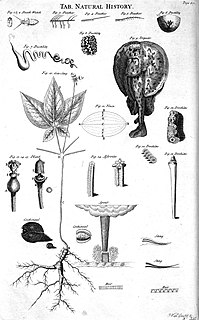
The Fennec fox, or fennec, is a small crepuscular fox found in the Sahara of North Africa, the Sinai Peninsula, South West Israel and the Arabian desert. Its most distinctive feature is its unusually large ears, which also serve to dissipate heat. Its name comes from the Berber word (fanak), which means fox , and the species name zerda comes from the Greek word xeros which means dry, referring to the fox's habitat. The fennec is the smallest species of canid. Its coat, ears, and kidney functions have adapted to high-temperature, low-water, desert environments. Also, its hearing is sensitive enough to hear prey moving underground. It mainly eats insects, small mammals, and birds.
Dog food is food specifically formulated and intended for consumption by dogs and other related canines. Like all carnivores, dogs have sharp, pointed teeth, and have short gastrointestinal tracts better suited for the consumption of meat than of vegetable substances. In spite of this natural carnivorous design, dogs have still managed to adapt over thousands of years to survive on the meat and non-meat scraps and leftovers of human existence and thrive on a variety of foods, with studies suggesting dogs' ability to digest carbohydrates easily may be a key difference between dogs and wolves.

An animal shelter or pound is a place where stray, lost, abandoned or surrendered animals, mostly dogs and cats, and sometimes sick or wounded wildlife are kept and rehabilitated. While no-kill shelters exist, it is sometimes policy to euthanize sick animals, and any animal that is not claimed quickly enough by a previous or new owner. In Europe, of 30 countries included in a survey, all but four permitted the killing of healthy stray dogs. Critics believe the new term "animal shelter" is generally a euphemism for the older term "pound". The word "pound" had its origins in the animal pounds of agricultural communities, where stray livestock would be penned or impounded until claimed by their owners. Some shelters even have sick tropical animals.
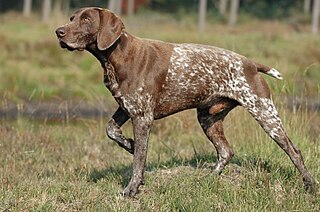
The German Shorthaired Pointer (GSP) is a medium to large sized breed of dog developed in the 19th century in Germany for hunting. A versatile hunting breed, being an all-purpose gun breed of dog suitable for both land and water, it is streamlined yet powerful with strong legs that make it able to move rapidly and turn quickly. It has moderately long floppy ears set high on the head. Its muzzle is long, broad, and strong, allowing it to retrieve even heavy game. The dog's profile should be straight or strongly Roman nosed; any dished appearance to the profile is incorrect. The eyes are generally brown, with darker eyes being desirable; yellow or "bird of prey" eyes are a fault. The tail is commonly docked, although this is now prohibited in some countries. In the current breed standard the tail is docked at approximately 40% of its length before it curves. In competition the dog is penalized if the tail is curved either up or down while the dog is moving. When the GSP is in classic point stance, the tail should be held straight out from the body, forming a line with the pointing head and body. Like all German pointers, GSPs have webbed feet. They are known for going after water fowl in the water.

The Lakeland Terrier is a dog breed, which takes its name from its place of origin, the Lake District in England. The dog is a small to mid-size member of the Terrier family. While independent in personality, it interacts well with owners and all family members, and is mostly hypo-allergenic. The breed is not widely owned in the United States.
The Pet Travel Scheme ("PETS") is a system which allows animals to travel easily between member countries without undergoing quarantine. A pet passport is a document that officially records information related to a specific animal, as part of that procedure. The effect is to drastically speed up and simplify travel with and transport of animals between member countries, compared to previous procedures, if the regulations are followed.

Battersea Dogs & Cats Home is an animal shelter that rescues cats and dogs in need of help and nurtures them until an owner or a new home can be found. It was established in Holloway, London in 1860 and moved to Battersea in 1871.
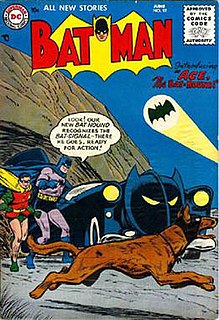
Ace the Bat-Hound is a fictional character appearing in American comic books published by DC Comics, commonly as the canine crime-fighting partner of Batman and Robin.
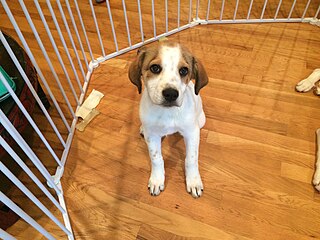
A rescue dog is a dog that has been placed in a new home after being abused, neglected, or abandoned by its previous owner. The term can also apply to dogs that are found as strays, surrendered by owners for a variety of reasons, including relationship breakdowns, moving home where the owner is unable or unwilling to take their pets, or elderly people who are not permitted to take their dog(s) into a nursing home.

A pet store or pet shop is a retail business which sells different kinds of animals to the public. A variety of animal supplies and pet accessories are also sold in pet shops. The products sold include: food, treats, toys, collars, leashes, cat litter, cages and aquariums. Some pet stores provide engraving services for pet tags, which have the owner’s contact information in case the pet gets lost.
An animal rescue group or animal rescue organization is dedicated to pet adoption. These groups take unwanted, abandoned, abused, or stray pets and attempt to find suitable homes for them. Many rescue groups are created by and run by volunteers, who take the animals into their homes and care for them — including training, playing, handling medical issues, and solving behavior problems — until a suitable permanent home can be found.

The Tosa is a breed of dog of Japanese origin that is considered rare. It was originally bred in Tosa, Shikoku as a fighting dog and is the only breed still used (legally) in Japanese dog fighting. Ownership is restricted in some countries as a dangerous breed.
John Burton is a British conservationist and author.

The Kerry Beagle is one of the oldest Irish hound breeds, believed to be descendant from the Old Southern Hound or the Celtic Hounds. It is the only extant scent hound breed native to Ireland.

The Wetterhoun is a breed of dog traditionally used as a hunting dog for hunting small mammals and waterfowl in the province of Fryslan in the Netherlands. The name of the dog comes from the West Frisian Wetterhûn meaning "water dog." Plural of Wetterhoun is Wetterhounen in Dutch. The breed may also be called the Otterhoun or Dutch Spaniel, although it is not a Spaniel-type dog.

A giant dog breed has no universal height or weight classification, although some groups define "giant breeds" as those heavier than 50 kilograms (110 lb). Giant breeds grow rapidly, but take longer to mature into their full adult sizes than smaller dogs.
DogsBlog.com is a UK dog rescue website founded by Ryan O'Meara and Kim Bruce, and set up by K9 Media Ltd. It was launched in January 2007, and has since found new homes for over 21,000 dogs via the website which provides a free service for 212 different rescue shelters.
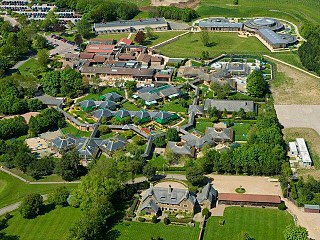
The Waltham Centre for Pet Nutrition is a research organisation owned by Mars, Incorporated located at Waltham on the Wolds, Leicestershire, United Kingdom. Waltham conducts scientific research into pet care and nutrition, and works with a number of animal breeds including dogs, cats, birds, fish and horses.
Marc de Henrie is a British photographer.
